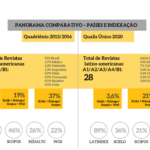By Lilian Nassi-Calò

Adapted photo from the original: Tom Davidson.
The publication of an article is the final and perhaps the most relevant step of scientific research. Writing and submitting the manuscript takes the researchers’ time and effort and involves an entire editorial chain that includes editors, peer reviewers, librarians, translators, publishers and other specialists. The evaluation of the article submitted for publication considers the relevance and originality of the research, the methodological soundness, the statistical validity of the results and the quality of the reporting. Ethical aspects of experimentation and writing are also evaluated, as well as the suitableness of the subject considering the type of contribution and the journal scope.
Instructions to authors (IA) are an integral part of the editorial policy and management of a journal and inform the authors on the proper structuring and submission of a manuscript. Well elaborated IA help preventing the rejection of unsuitable manuscripts. Incomplete or outdated instructions result in higher number of rejections, frustrating authors and overloading the editorial management process. However, this section is often neglected by most editors, who do not seem to realize its importance. Well written, transparent and openly available instructions on the journal’s Web page are a prerogative of journal quality and positively influence their indexing in reputable bibliographic databases.
There are few reports in the literature on the content and specificity of the IA, unlike topics such as peer review, ethics in scientific communication, journal assessment and impact evaluation. It is worth mentioning that a journal entirely dedicated to such topics has just been launched: ‘Research Integrity and Peer Review Journal’, a BioMed Central publication endorsed by the EQUATOR Network and by the International Society of Managing Technical Editors, which aims to promote good practices and transparency on health research through guidelines for research reports.
IA in the literature
A study on the ethical aspects of research with human beings contained in the IA of 139 Brazilian journals published in 20001 concluded that 79% made no reference to ethical issues, such as analysis by Ethics Committees, the Helsinki Declaration, Free and Informed Consent, or requirements of the International Committee of Medical Journal Editors (ICMJE).
A paper by Schriger and Altman in 20062 evaluated the IA of 166 Medical Science journals regarding homogeneity, extent and presence of guidelines on methodological and statistical issues in assessing the quality of research reports. The authors reported a high heterogeneity in the IA extent and that a small part of the section is devoted to guidance on methodology or assessment of the statistical significance of the results, often containing contradictory information. Moreover, about 60% of the analyzed journals made no reference to the ICMJE guidelines and nearly 80% did not mention other guidelines such as CONSORT, STARD, or any others. Most of the IA, the authors conclude, was devoted to questions concerning the formatting of manuscripts.
Another 20073 study analyzed 20 Health Sciences Brazilian journals that publish articles on Surgery for the presence of ICMJE requirements (known as the Vancouver guidelines) in the IA. The authors found that 90% required compliance with ethics codes on experimentation and scientific writing; 70% required a declaration of conflicts of interest; 75% have adopted the ICMJE recommendations for preparation of the manuscripts; and 80% specified the type of peer review process adopted in the articles selection.
Ideally, the IA should include details on the peer review process used by journals such as the blinding approach adopted, whether the reviews are made openly available, whether post-publication peer review takes place, etc. In this sense, Hirst and Altman published in 2012 an article in PLoS One4 on the recommendation of publishing guidelines in the peer review process of 116 Health Science journals. The authors, it is important to mention, are part of the EQUATOR Network staff at the Centre for Statistics in Medicine, University of Oxford, UK. Assuming that the publication of guidelines help both researchers in the writing the manuscript as peer reviewers providing tools to better assess the articles, the study evaluated the presence of publication guidelines in different sections of the IA. The 116 journals evaluated comprised the McMaster journal list, reviewed by the American College of Physicians, and yet only 35% (41 journals) disclosed guidance to peer reviewers in the IA. Of these, only 19 journals contained specific orientation on publications guidelines as CONSORT, STROBE, EQUATOR and the like.
This finding was confirmed by another study5 that evaluated the IA of 56 Biomedicine journals of Latin America and the Caribbean according to publishing guidelines and the mandatory registration of clinical trials. Only eleven journals (20%) mentioned some of the following guidelines: CONSORT, PRISMA, STROBE and EQUATOR. As for the registration of clinical trials, 20 journals (36%) required prior registration of trials on an open access database. Furthermore, 38 journals (68%) advise on the use of ICMJE recommendations in manuscript preparation.
An article from 20146 assessed in details the content of the IA of 44 Rheumatology journals selected from the SCImago Journal & Country Rank database. The aspects analyzed included the journal’s scope and publication priorities, format and references, type of peer review, authorship, conflicts of interest, plagiarism and duplicate publication, copyright, open access and APC. The authors found a positive relationship between the impact of the evaluated journals, as measured by their H index and Impact Factor and the level of detail of the IA section, despite some regional differences. In the sample evaluated, instructions for conducting peer review and authorship criteria are among the least mentioned in the IA. According to the authors, there are no universally accepted instructions for a discipline, as it occurs, for example, with the ICMJE recommendations. Therefore, each journal, either independent or part of a large publisher, ought to develop and periodically review the instructions, in order to provide the authors with all necessary information to prevent inappropriate or poor quality submissions. The SciELO network recommends that the IA are reviewed annually.
Another relevant aspect of the IA is the disclosure of potential conflicts of interest. A recent publication7 evaluated this issue in the IA of 64 Surgery journals from the Journal Citation Reports (JCR) database. In eight journals (12%), the disclosure of conflicts of interest was considered unnecessary, while in the remaining 56 journals (88%), this information was mandatory. In 39 publications, the declaration of conflict of interest was published as part of the article. The authors also observed that these journals had a higher Impact Factor, when compared to the others, a feature credited to the increased reliability of the studies published.
Characteristics of the IA of Brazilian Health Sciences journals
In order to evaluate the content and quality of the IA of Brazilian journals, we sampled 94 Health Science journals of SciELO Brazil. The instructions of each journal were evaluated according to 17 criteria: date of last update of the IA, scope and editorial policy statement, language of the articles published, language of the IA, responsible institution, number of editors-in-chief, research ethics committee, compliance with ICMJE recommendations, statement on conflict of interest, authors’ contribution statement, policy on clinical trial registration, use of publishing guidelines, keywords assigned according to DeCS/MeSH, type of Creative Commons License adopted, authors identification by ORCID or similar, online submission system adopted, and APC collection.
Journals are highly heterogenic regarding the content, structure and length of the IA. Some criteria, however, are fairly uniform. No journal makes refers to editorial freedom and independence and scientific conduct, as advocated by the ICMJE recommendations. Seventy-three journals (78%) out of 94 did not review the IA in recent years, many possibly date from their entry into the SciELO collection. Sixty-seven journals (71%) have well-defined editorial policy and scope. Thirty percent of journals publish articles in English and/or Portuguese, 26 (28%) publish in Portuguese and/or English and/or Spanish and 37% publish only in English, which makes the health area the largest contributor to the percentage of English papers in SciELO Brazil. The language of the IA, therefore, follows this trend, with 90% of the journals providing the instructions in both English and Portuguese. The remaining 10% have only instructions in English, a feature of journals that publish solely in this language.
Regarding responsible institution, more than half of the journals are managed by scientific societies or professional associations. About one third is from universities, mostly public ones. The rest is managed by non-academic research institutions, and there is only one commercial company as responsible institution. As the number of editors-in-chief, the vast majority of journals (75%) have one editor-in-chief, 17% have two editors-in-chief, and few have more than two. Only one journal did not indicate an editor-in-chief.
As expected in the case of Health Science journals, 90% explicitly state and follow the ICMJE recommendations. Others adopt the norms by the Brazilian Association of Technical Standards (Associação Brasileira de Normas Técnicas, ABNT). As for the other criteria that are part of the ICMJE recommendations, 74 journals (79%) require a declaration of conflicts of interest, but only 25 (27%) include the individual contribution of the authors. Of these, only three journals recommend identifying authors by their ORCID identifier. The registration of clinical trials is a prerequisite for publication in 61 journals (65%). One third of the publications recommend using publishing guidelines in addition to, or instead of ICMJE, especially CONSORT, COPE and PRISMA. Seventy-five percent of the editors recommend the attribution of keywords according to DeCS or MeSH, and the rest do no mention such controlled vocabularies for keywords attribution.
The issue of clinical trial registry gained prominence in the academic community a few weeks ago, when the blog Retraction Watch8 reported the decision of the journal Annals of Internal Medicine to update its IA9 in order to include the mandatory publication, along with the article, of experimental protocols and every changes made over the duration of the clinical trials. According to the executive deputy editor Darren Taichman, the decision of the journal to publish clinical trial protocols had been taken long ago, but has been accelerated due to the news that the COMPare10 initiative would have encountered barriers in obtaining a certain protocol for one of the studies under evaluation. Taichman reported that the protocols were systematically and internally reviewed as part of the peer review process, but the decision to publish them aims to increase the tests’ transparency. The expectation is that SciELO journals progressively adopt this policy.
The open access Creative Commons Licenses are used by all the journals assessed, since it is a recommendation of SciELO Brazil. Seventy of them (74%) use the least restrictive license, CC-BY. Fifteen percent use the CC-BY-NC, which prohibits the use of the contents for commercial purposes and 10% use the most restrictive license, CC-BY-NC-ND, which does not allow to change or to use contents for commercial purposes. However, it is expected that in the near future most journals will adopt CC-BY to minimize access and use barriers.
The use of online submission systems is one of the recommendations of the SciELO criteria published in 2014, to allow the collection of data and statistics of manuscripts rejection rate, and to promote transparency in editorial management. Just over half (51%) the journals use the Scholar One system, 16% use the Open Journal System, and 30% use other systems. Currently, only six journals do not use any online submission system, but those shall do it soon. Finally, regarding the collection of article processing charge (APC) only 17 journals (18%) use this source of revenue, and three journals charge only to publish color figures in the printed version.
In general, the IA of Health Science journals in SciELO Brazil are outdated and most dedicate much of the content to format and references issues. Only 17 journals have updated their IA versions in the past two years. However, relevant issues such as registration of clinical trials, statement on conflict of interest and compliance with ICMJE recommendations are followed by most journals. The expectation is that in the near future the journals enrich their IA section with the main aspects of editorial policy and annually update the texts, considering the advances in editorial policy and management, as well as the state of the art in scientific communication.
None of the journals of the sample evaluated included any recommendations for peer reviewers in the IA. Some just report that the manuscripts are sent to two or three referees and their comments will be made available to the authors. It is possible that information in this regard is found in the pages reserved to peer reviewers in the online submission systems. However, it would be desirable that the journals publish openly instructions on how to conduct the peer review, in view of the importance of this matter.
As stated Gasparyan, et al.6, there is no universal format for the IA. However, there are exemplary instructions in journals such as the New England Journal of Medicine, The Lancet, JAMA, Nature Medicine, Annals of Rheumatic Diseases, Annals of Emergency Medicine and Annals of Internal Medicine, among others, besides the recommendations found in ICMJE, COPE, EASE and WAME websites, which can serve as parameters to editors. However, more important than writing quality instruction, it is to ensure that the manuscripts’ assessment process enforce them properly.
Notes
1. SARDENBERG, T., et al. Análisis De Los Aspectos Éticos De La Investigación En Seres Humanos Contenidos En Las Instrucciones A Los Autores De 139 Revistas Científicas Brasileñas. Acta bioeth. 2000, vol. 6, nº 2, pp. 293-307. DOI: 10.4067/S1726-569X2000000200008.
2. SCHRIGER, D.L., ARORA, S., and ALTMAN, D.G. The Content of Medical Journal Instructions for Authors. Ann. Emerg. Med. 2006, vol. 48, nº 6, pp. 744-749. DOI: 10.1016/j.annemergmed.2006.03.028.
3. PELLIZZON, R.F., et al. Brazilian scientific journals in surgery. III: analysis of the instructions for authors based on Vancouver uniform requirements. Acta Cir. Bras. 2007, vol. 22, nº 6, pp. 503-510. DOI: 10.1590/S0102-86502007000600016.
4. HIRST, A. and ALTMAN, D.G. Are Peer Reviewers Encouraged to Use Reporting Guidelines? A Survey of 116 Health Research Journals. PLoS one, 2012, vol. 7, nº 4, e35621. DOI: 10.1371/journal.pone.0035621.
5. REVEIZ, L., et al. Compliance with Clinical Trials Registration and Reporting Guidelines by Latin American and Caribbean Journals. Cad. Saúde Publica. 2013, vol. 29, nº 6, pp. 1095-1100. Available from: http://ref.scielo.org/zjjwg4. PMID: 23778541.
6. GASPARYAN, A.Y., et al. Upgrading instructions for authors of scholarly journals. Croat Med J. 2014, vol. 55, nº 3, pp. 271-280. DOI: 10.3325/cmj.2014.55.271.
7. PROBST, P. et al. Thirty years of disclosure of conflict of interest in surgery journals. Surgery. 2015, vol. 157, nº 4, pp. 627-33. DOI: 10.1016/j.surg.2014.11.012.
8. In major shift, medical journal to publish protocols along with clinical trials. Retraction Watch. 2016. Available from: http://retractionwatch.com/2016/05/13/in-major-shift-annals-to-publish-protocols-along-with-clinical-trials/
9.Annals of Internal Medicine. Information for authors. American College of Physicians. Available from: http://annals.org/public/authorsinfo.aspx#protocols-and-other-materials
10. The COMPare (http://compare-trials.org/) initiative is an independent organization that monitors clinical trials published in five journals (NEJM, JAMA, The Lancet, Annals of Internal Medicine e The BMJ).
References
Annals of Internal Medicine. Information for authors. American College of Physicians. Available from: http://annals.org/public/authorsinfo.aspx#protocols-and-other-materials
BOSSUYT, P.M., et al. STARD 2015: an updated list of essential items for reporting diagnostic accuracy studies. BMJ. 2015, nº 351, h5527. DOI: 10.1136/bmj.h5527.
GASPARYAN, A.Y., et al. Upgrading instructions for authors of scholarly journals. Croat Med J. 2014, vol. 55, nº 3, pp. 271-280. DOI: 10.3325/cmj.2014.55.271.
HIRST, A. and ALTMAN, D.G. Are Peer Reviewers Encouraged to Use Reporting Guidelines? A Survey of 116 Health Research Journals. PLoS one, 2012, vol. 7, nº 4, e35621. DOI: 10.1371/journal.pone.0035621.
In major shift, medical journal to publish protocols along with clinical trials. Retraction Watch. 2016. Available from: http://retractionwatch.com/2016/05/13/in-major-shift-annals-to-publish-protocols-along-with-clinical-trials/
PELLIZZON, R.F., et al. Brazilian scientific journals in surgery. III: analysis of the instructions for authors based on Vancouver uniform requirements. Acta Cir. Bras. 2007, vol. 22, nº 6, pp. 503-510. DOI: 10.1590/S0102-86502007000600016.
PROBST, P. et al. Thirty years of disclosure of conflict of interest in surgery journals. Surgery. 2015, vol. 157, nº 4, pp. 627-33. DOI: 10.1016/j.surg.2014.11.012.
REVEIZ, L., et al. Compliance with Clinical Trials Registration and Reporting Guidelines by Latin American and Caribbean Journals. Cad. Saúde Publica. 2013, vol. 29, nº 6, pp. 1095-1100. Available from: http://ref.scielo.org/zjjwg4. PMID: 23778541.
SARDENBERG, T., et al. Análisis De Los Aspectos Éticos De La Investigación En Seres Humanos Contenidos En Las Instrucciones A Los Autores De 139 Revistas Científicas Brasileñas. Acta bioeth. 2000, vol. 6, nº 2, pp. 293-307. DOI: 10.4067/S1726-569X2000000200008.
SCHRIGER, D.L., ARORA, S., and ALTMAN, D.G. The Content of Medical Journal Instructions for Authors. Ann. Emerg. Med. 2006, vol. 48, nº 6, pp. 744-749. DOI: 10.1016/j.annemergmed.2006.03.028.
External links
Consolidated Standards of Reporting Trials (CONSORT) – <http://www.consort-statement.org/>
Enhancing the QUAlity and Transparency Of health Research (EQUATOR) – <http://www.equator-network.org/>
McMaster journal list – <http://hiru. mcmaster.ca/hiru/journalslist.asp>
ORCID – <http://orcid.org/>
Preferred Reporting Items for Systematic Reviews and Meta-Analyses (PRISMA) – <http://www.prisma-statement.org/>
Research Integrity and Peer Review Journal – <http://researchintegrityjournal.biomedcentral.com/>
SCImago Journal & Country Rank – <http://www.scimagojr.com/>
STrengthening the Reporting of OBservational studies in Epidemiology (STROBE) – <http://www.strobe-statement.org/>
 About Lilian Nassi-Calò
About Lilian Nassi-Calò
Lilian Nassi-Calò studied chemistry at Instituto de Química – USP, holds a doctorate in Biochemistry by the same institution and a post-doctorate as an Alexander von Humboldt fellow in Wuerzburg, Germany. After her studies, she was a professor and researcher at IQ-USP. She also worked as an industrial chemist and presently she is Coordinator of Scientific Communication at BIREME/PAHO/WHO and a collaborator of SciELO.
Translated from the original in portuguese by Lilian Nassi-Calò.
Como citar este post [ISO 690/2010]:

















Read the comment in Spanish, by Javier Santovenia:
http://blog.scielo.org/es/2016/08/03/instrucciones-a-los-autores-de-revistas-en-salud-que-es-lo-que-comunican/#comment-39599
Read the comment in Portuguese, by Emanuela Martins:
http://blog.scielo.org/blog/2016/08/03/instrucoes-aos-autores-de-periodicos-em-saude-o-que-comunicam/#comment-24766